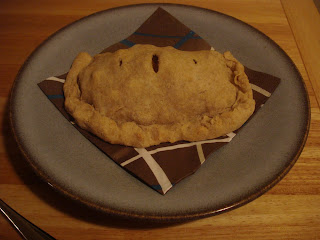
I love cooking Indian food. I love the colors, the flavors, and the way it makes my kitchen smell when I am cooking it.
This time of year, I am looking to use my collection of potatoes and onions I've been cellaring for a while. They're showing their age, if you will, and need to be used in something. My kitchen lacking much else when I made the decision to compile something out of these ingredients, I immediately went to my spice cabinet and started digging around. (If you need inspiration for food, start in your spice cabinet - it can bring some great ideas to life.) I found a bag of curry powder I bought in bulk last fall, and thought, "yes, curry!" And so the dish begins.
This dish is a mash up of several curry dishes I've made over the years, and actually doesn't contain curry powder, but instead is made up of some of the spices which make up curry powder. The nice thing about dishes like this is that you can modify them quite a bit based on what you have in your kitchen. As I mentioned before, I didn't have much to work with so what is below is a pretty basic, but extremely delicious. You could make additions or modifications to the recipe, for example:
- Add three diced fresh tomatoes (or a 28-oz can of diced tomatoes) when you add the broth
- Add 3 tablespoons of lemon or lime juice
- Increase the amount of red pepper flakes for added heat
- Add sweet potatoes, carrots, or cauliflower instead of just potatoes (but keep the amounts about the same or you'll need more liquid and spices)
- Add a can of chickpeas when you add the broth for added protein
- If you're feeling adventurous, add some paneer cheese for a delicious protein alternative
Enjoy!
Potato Pea Curry
Makes about 4 servings
3 cups red-skinned potatoes (yukons or russets work fine too), cut into a 1/2-inch dice
1/4 c olive oil or clarified butter
2 large onions, diced
1 tbsp garlic, minced finely
1 tbsp freshly grated ginger*
2 1/2 tbsp ground cumin
1 tsp turmeric
1/2 tbsp ground coriander
1/2 tsp dried red pepper flakes
3 cups veggie broth
1/2 tbsp salt
2 cups fresh or frozen peas (if frozen, thaw them out first)
1 tbsp brown sugar
Rinse the potatoes until the water runs clear to remove excess starch.
In a heavy saucepan over medium-high heat, heat the oil or butter. Add the onions and saute until soft. Add the potatoes and saute for another 5 to 8 minutes, until they are slightly browned. Add the garlic & ginger, and cook just long enough to release their aromas. Remove from heat (but don't turn off the burner).
Add the cumin, turmeric, coriander, and red pepper flakes. Return to the stove and cook on medium heat, stirring constantly, for 12 minutes (stirring constantly will prevent the spices from burning on the bottom of the pan). Add broth and salt.
Bring to a boil and simmer for about 15 minutes or until the potatoes are tender. Add the remaining ingredients and continue to simmer until peas are heated through.
*A few tips on ginger: buy a large piece of ginger and store it in your freezer. When you need it, simply pull it out of the freezer and grate it with a hand grater. A hand grater is also great for getting a "minced" garlic without all the chopping; just peel the cloves and grate them right over the pot!

